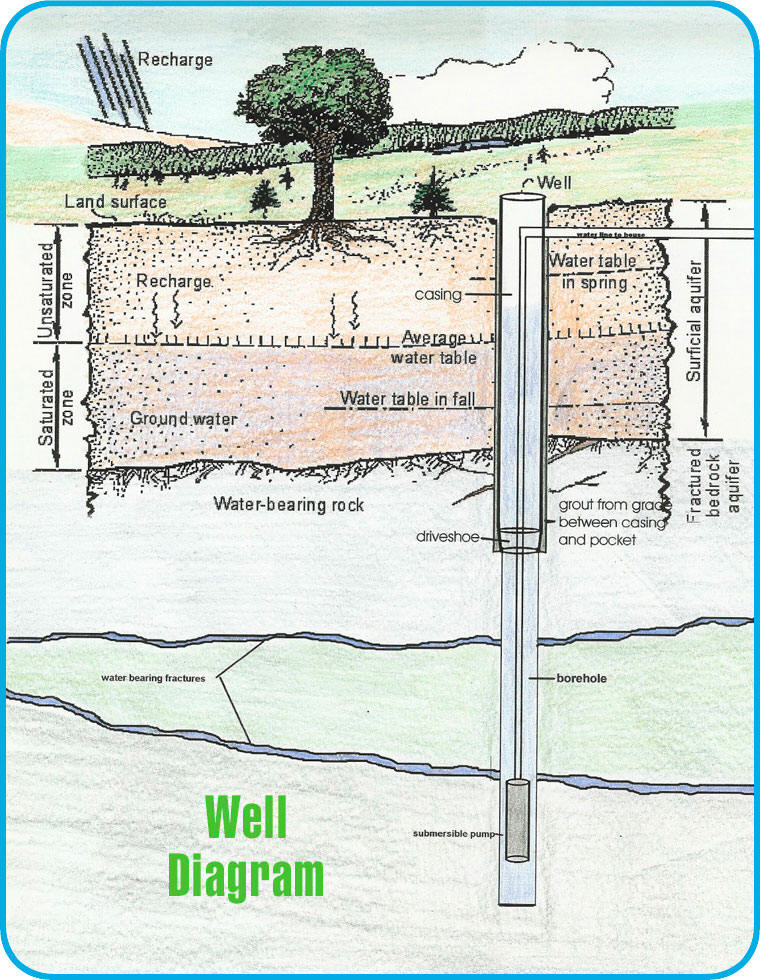FAQs
Please click on the links below to view the FAQ answers
What is Water Well Drilling?
Well drilling is the process of drilling a hole in the ground for the extraction of a natural resource such as ground water, natural gas, or petroleum. Drilling for the exploration of the nature of the material underground (for instance in search of metallic ore) is best described as borehole drilling, or 'drilling'.
The earliest wells were water wells, shallow pits dug by hand in regions where the water table approached the surface, usually with masonry or wooden walls lining the interior to prevent collapse. Modern drilling techniques utilize long drill shafts, producing holes much narrower and deeper than could be produced by digging.
Well drilling can be done either manually or mechanically and the nature of required equipment varies from extremely simple and cheap to very sophisticated.
How much water will my well make?
There is no way to determine the amount of water a well will make until the well has been completed. In some parts of our drilling area the water is found only in random bedrock fractures. These wells typically yield about one to two gallons per minute. In other areas, yields of seventy gallons per minute are common. When you call us with the geological location of your land, we can let you know what the wells around your property yield, although that does not always indicate exactly how much water your well will yield.
The more important question would be to ask how much water will be needed. For homeowners, the average adult uses between seventy five to one hundred (75-100) gallons per day. Therefore, four hundred (400) gallons per day should be able to meet the needs of a family of four, and the actual use would be only a little over one quarter (1/4) gallon per minute. Landscaping, greenhouses, swimming pools, hot tubs, livestock and pets require considerably more water. An external tank located in the basement or underground may be needed to draw water from the well and store it for times of peak usage if the usage will be equal to the production of the well.
Where should the well be located?
Three important considerations exist for locating where your home water well will be drilled. It needs to be
Away from sources of contamination.
Convenient to power supply and pipe installation.
Accessible for drilling rig and pump installing equipment.
If possible, always locate the well at a higher elevation than any waste water septic system or drainage system. State laws also specify minimum acceptable distances between wells and other structures. Old and abandoned wells should be filled and sealed by a licensed well driller to avoid contamination of the new well
.
Why do different drillers use different types of equipment?
Our company is dedicated to providing the best possible well on the property that you have selected. We use a state-of-the-art air rotary system that advances the bit by injecting water, along with compressed air, to clean the well bore and lift the cuttings and rock chips to the surface. Periodically the rig is stopped so that the driller can test for water. Mud rotary drillers, however, use a bentonite clay mixture to support the sides of the boring so that the material will not cave in the boring. The mixture creates a cake that stabilizes the sides and it will seal off water, making the detection of lower yields difficult. This seal will hold water back until the well is cleaned by post-drilling development or until it is plugged as a dry hole. When we encounter difficult drilling conditions such as sand and gravel, we now use a Drillan Drive system installed on our rotary rig, the first of its type in the United States. This enables us to advance casing through unstable materials as we drill, allowing us to continue to avoid the problems associated with drilling using mud.
What if we don't find water??
No ground water contractor wants to drill a "dry" hole. It is also unlikely, but when dealing with subsurface geology, it is difficult to guarantee finding water or to predict its quantity and quality. Therefore, most pricing includes this as a possibility.
